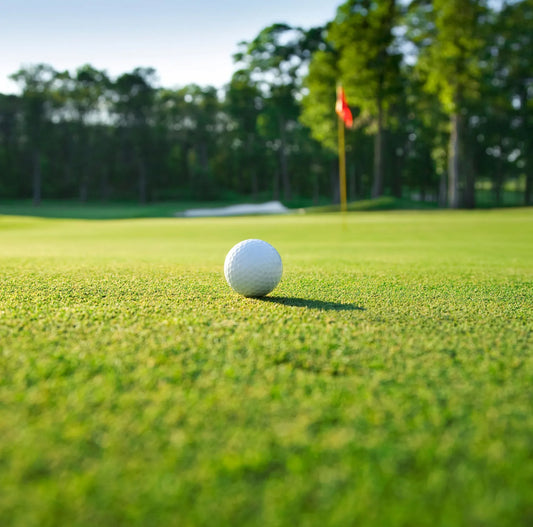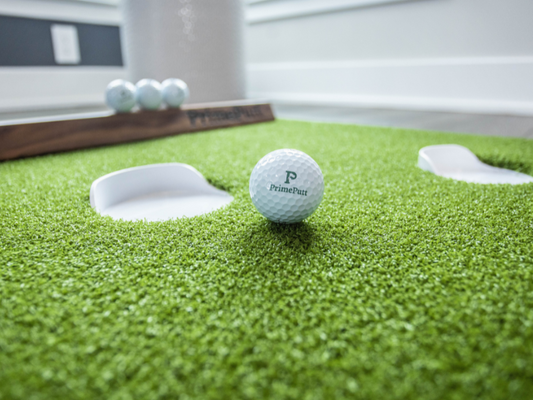Green speed remains a frequently misconstrued subject in the realm of golf, with even seasoned golfers lacking certain insights into it. For example, green speeds are variable, influenced by factors such as temperatures, humidity, rainfall, and routine maintenance practices, all resulting in daily fluctuations.
Throughout your golfing career, you will encounter varying green speeds, especially if you travel to play at different courses. For instance, Augusta National Golf Club, Oakmont Country Club, and Royal Melbourne Golf Club have much faster greens than any local municipal golf course. You can see some of the smallest and shortest putting strokes in competition by watching the U.S. Open at OCC or the Masters Championship.
Watching the best players in the world putt at these venues’ greens is quite a sight. Players barely move their putter heads to create a putting stroke, yet the ball can travel up to 20 feet. To improve your understanding of how green speed affects the length of your putting stroke, you need to practice specific speed control techniques. It is imperative to build a practice plan that focuses on learning green speeds to become a better putter.
Understanding green speeds and adjusting the length of your putting stroke accordingly takes a lot of concentration and practice. Just like with any skill, repetition is crucial to achieving mastery. In this article, we will teach you how to develop a practice plan that helps you understand the relationship between the length of your putting stroke and distance control.
Does Putting Really Impact Your Score?
Your putting stroke may be the smallest stroke you make in a round, but statistically, it has the greatest impact on your scorecard. Putting accounts for roughly half of your strokes in a round of golf, compared to only 14 shots taken with your driver. Yet, despite knowing the impact that putting can have on your overall score, many golfers neglect to practice this vital aspect of the game at the same rate they feel its impact.
Developing touch on the greens and having good speed control undoubtedly takes a considerable amount of time and effort. It's not helpful to guess how far to pull back your putter when standing 30 feet away from the hole.
Imagine playing a round of golf without knowing the distances you hit with each of your other clubs. None of us would want to do that, nor would we be consistently successful at the guessing game. But this is exactly how many golfers approach their putting. They get frustrated when they lack good distance control and cannot adjust to the speed of the greens throughout a round. The truth is, if you don't practice, it's difficult to rely on any part of your game to be consistent or successful.
How to Master Green Speed and Distance Control
If you want to improve your putting and lower your score, you need to commit to practicing it. The best way to get better at putting is to make a practice plan that includes different speed drills. Consistent practice is crucial if you want to be able to putt a ball with a reasonable margin of error from the distance you originally intended.
There are a lot of putting drills on the internet now, and the Golf Channel is always advertising the newest and best way to improve your game. But how can you figure out what will really help you get better at distance control and figuring out the right length for your putting stroke?
Stick to tips and training aids that don't sound gimmicky or too good to be true. If a drill claims to improve your putting with minimal effort or promises to be the only training aid you'll ever need, it's best to avoid it. Add the following drills to your daily putting practice to get used to different green speeds and distance control.
It's also important to become a master at adapting your putting technique to match different green conditions. Every green plays differently, so you have to know how to tweak your putts accordingly to succeed.
Distance Control Practice Drill
The “ladder drill” is a simple yet effective putting drill aimed at improving distance control for mid-to-long putts. Many golfers struggle to maintain consistency in their distance control by merely varying the force they apply to the ball. This drill aims to shift golfers' focus from force to momentum, helping them develop a smoother and more reliable putting stroke.
The Setup
To begin, find a flat stretch of green without severe slopes and set up four balls in a row, creating a straight line across the green. Soft hands are essential for this exercise, so avoid gripping the putter too tightly, allowing for a fluid and solid motion.
Performing the Drill
The key to success in this drill is to maintain a consistent rhythm, using a tick-tock or 1-2 tempo (try to envision having a metronome in your head). Start with a small tick-tock for the first putt and maintain the same tempo while gradually lengthening the backswing and follow-through for each subsequent putt. The objective is to create a perfectly staggered and consistent ladder of balls, with each one traveling slightly further than the one before.
Avoid looking to see where each ball finishes, as it can influence how you hit the next one. Instead, focus on maintaining the same tempo throughout all four putts, which will allow you to gauge distance simply by the length of your stroke.
If an outlier ball deviates significantly from the rest, you may have either hit the ball too hard or decelerated. Repeat the drill until you achieve consistently even ladders in cases like these.
Once you've mastered this drill, take note of the length of your strokes and visualize the motion you used for each putt. This visualization will help reinforce the distance required for each stroke.
By practicing this drill regularly and developing the ability to control distance through a smooth and consistent stroke, you'll notice a significant improvement in your putting accuracy and overall scoring. It will also enhance your confidence on the golf course, leading to fewer three-putts and saving you valuable strokes.
Speed Drill
Here's a drill you can incorporate into your practice sessions to help you adjust the length of your putting stroke to different green speeds.
The Setup
You will need six tees and five golf balls. Set up the six tees in a straight line, 10 feet apart from each other, totaling 50 feet in length. Only putt from the end tees of the line. After putting all five balls from one end tee, move to the opposite end tee and repeat the drill, never putting from the inner tees.
Performing the Drill:
- From one of the end tees, hit one ball to each of the other tees on the line. Go through your entire putting routine as if you were playing a round of golf.
- From the same end tee, hit your first ball to the 10-foot tee. Your goal is to stop the ball 12–18 inches behind the tee.
- Without moving, hit your second ball to the 20-foot tee, aiming for the same 12–18-inch stopping range behind the tee.
- Repeat this for the 30-foot tee.
- For the 40- and 50-foot tees, your goal is to be within 24 inches of the tee, which mimics a lag putt you might encounter on the course. The goal is to maintain your stroke length while adapting it to the speed of the greens.
- You should go through this drill for at least 20 to 30 minutes. Once you have hit all five of your golf balls, you will then collect them and switch to beginning the drill at the tee on the opposite end before repeating.
By doing this drill often, you will learn how to change the length of your putting stroke depending on how fast the green is moving. This will help you get a better handle on distance and, in the end, lower your score.
Most practice putting greens are not flat, which is ideal for this drill. You should switch from one end to the next to practice uphill, downhill, left-to-right, and right-to-left breaking putts. Ideally, the drill setup should have little undulation, but some is always welcome.
If the putting green has too much undulation to properly set up the drill to the full 50 feet in length, shortening it is allowed. In the same way, if the practice putting green isn't big enough to accommodate a 50-foot putt, make some changes.
This drill teaches you how far to take the putter back for different-length putts. It's set up to 50 feet because most golfers don't practice putts over 20 feet before playing, let alone during a practice session. As a result, these golfers struggle with lag putting beyond 25 feet. You need to work on a skill over and over, especially in golf, to be able to do it well and consistently.
The speed drill has a progression where you hit five putts in ascending order from both ends and then in descending order from both ends. However, you will never complete an ascending and descending run on the same side.
After finishing five putts, switch to the opposite end. Once you can do the drill in both ascending and descending order from both ends, pick tees at random to test your ability to judge distance. Eventually, your body will know exactly how far to bring the putter back for a 40-foot putt compared to a 35-foot or 45-foot putt. By consistently doing this drill, your body will learn how much to add or back off to hit putts of different distances outside the 10-foot increments.
To use this technique on the course, you'll need a baseline for your stroke length and green speed. The practice facility or home course where you spend most of your time practicing the drill will be your baseline for green speed.
When playing on new golf courses, spend 5 to 10 minutes doing this drill to adapt to the new green speed. You'll quickly notice if you're leaving putts short or blasting them past the hole. This will indicate whether you need to adjust your stroke length one way or the other. If you already know how to control distance, it will be much easier to adjust to different green speeds by making a shorter or longer putting stroke, depending on how fast the greens are.
Why Practice Matters and How PrimePutt Can Help
Improving at golf, like anything else, takes hard work and practice. While there are training aids available that can be helpful, golf is a game that even experts struggle to perfect. Plus, as you age, your body changes, affecting your strength, flexibility, swing speed, and endurance. As a result, you'll work on various aspects of your golf game throughout your hopefully long golf career.
To get better, you must always be willing to practice, both on and off the golf course, and do so in a planned way. If you really want to cut strokes from your round that aren't necessary, you need to practice outside of your 18-hole rounds.
A good first step to building a consistent practice routine is investing in a high-quality at-home putting setup. With the PrimePutt indoor putting mat, you can practice putting anywhere and get real-time feedback to help you get better at distance control. You can build muscle memory and feel with PrimePutt, which leads to consistent practice and better results.
Frequently Asked Questions
Want to learn more? Here are answers to commonly asked questions.
Can you have on-call distance control on the putting greens?
Yes! However, it takes a lot of practice to be able to have on-call distance control when putting. Making sure you practice longer distances is the key. Outside of 30 feet is where most golfers' speed control starts to falter, so practicing your longer putts is key.
Does green speed affect the length of your putting stroke?
Yes, it very much does. Depending on putting green quality and how fast the greens are, your putting stroke will be much smaller than normal, and vice versa; with slower greens, it will be much longer.
Do putts break more on fast or slow greens?
Putts generally break more on slower greens compared to fast greens. This phenomenon occurs because slower greens have more friction, causing the ball to grip the putting surface for a longer time. As a result, the ball tends to turn more and curve more dramatically during its roll.
What does putting green speed mean?
The "stimp" or "stimp rating" is a numerical measurement indicating the speed at which a golf ball rolls on putting green surfaces. This rating is commonly referred to as the "green speed" by golfers. The best way to assess green speed is by using a Stimpmeter.





